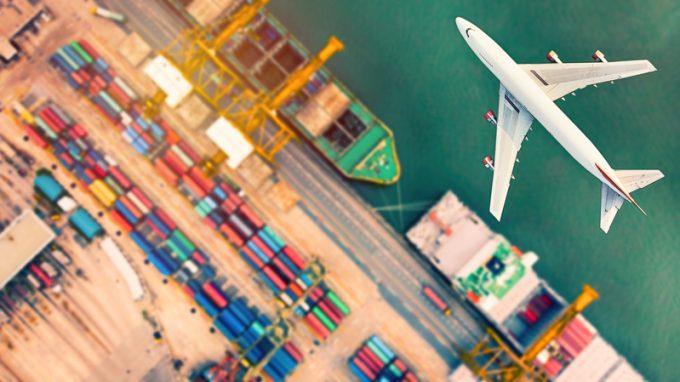MSC redeploys 'Israel-linked' box ships away from Persian Gulf
MSC, the only operator of Israel-linked containerships in the Persian Gulf, has begun shifting these ...

Sea-air providers are gearing up for a sudden rush in demand from shippers concerned at delays caused by vessels avoiding the Suez Canal, with fashion brands most likely to take up the offer.
While the airfreight and air charter market has not yet seen any pick-up in demand from the situation, sea-air routes via Dubai are expected to see an increase.
“We took our first booking on our combined liner sea-air service on Monday, on behalf of a forwarder working with a leisure brand,” said Hans-Henrik Nielsen, global development director at CargoGulf.
“If direct air rates peak, it will bring sea-air back into play. Container space ex-Asia to Dubai is super-tight right now, ocean freight is rocking up again, pre-Chinese New Year.
“German fashion-focused 3PLs are normally quick to switch to sea-air when disruption happens,” he said. “We are already fully booked to January, ex-Ningbo/Shanghai.”
He added that FCL rates were going up by $200 to $300 per teu every week, and that CargoGulf would likely add a PSS of $300 per teu from 15 January on Asia-Dubai.
Shipco Transport, a neutral NVOCC and airfreight wholesaler, said it was preparing for sea-air, to avoid disruption on both major canal arteries, alongside the Panama Canal also experiencing difficulties due to drought.
Noting a “perfect storm”, Kim Ekstroem, COO global air freight for Shipco, said: “While the Red Sea obviously is on the front pages right now, we will experience similar delays caused by Panama Canal issues, which will impact shipments from Asia into the Caribbean and the east coast of Central and South America.
“As a consequence, we are bracing for a huge demand for sea-air solutions. Our normal sea-air hubs – Dubai and Los Angeles – are not impacted.
“We have multiple weekly LCL services from all over Asia into Jebel Ali, from where we transfer to Dubai for airfreight to Europe, Middle East and Africa. Likewise, we have ocean services into Los Angeles from where we can fly directly – or via Miami – to destinations in South and Central America.”
Shipco also noted that the garment industry in particular favours sea-air.
“We always have a certain amount going. There are importers – especially within garments – that schedule around it and maintain sea-air as their main mode of transport.
“By and large, you need one of two factors for sea-air to be beneficial. Either high airfreight rates and low capacity (as we saw under the pandemic), or infrastructural challenge, as we saw with the Evergreen vessel stuck in the Suez Canal,” explained Mr Ekstroem.
“Right now, you have both situations; high rates and severe infrastructural challenges. It is a perfect storm brewing.”
Forwarders and wholesalers agree that the Red Sea situation has not yet impacted airfreight rates, which, in fact, this week have begun to fall, ex-Asia. One Shanghai-based forwarder said: “After almost three months of air freight hikes, air prices to Europe and North America started a steep drop-off since Monday. They should pick up again when we get closer to Chinese New Year [in February].
“The present Red Sea problem has not yet affected the air freight market.”
Mr Ekstroem added: “Generally speaking, the airfreight market ex-China and South-east Asia is starting to cool a little bit ahead of the holidays, but we expect it to come back strong early in the new year.
“The US, on the other hand, is rather busy these days and we are experiencing backlogs even into Europe.
“From a rate perspective, the Red Sea situation will have an impact on air rates. particularly from Asia to Europe and South America, making the sea-air model even more attractive.
“But, there is cargo that will be diverted to pure air right out of the gate. Many shippers have not forgotten the uncertainly and delays we experienced a bit more than a year ago, and they will take no chances.
“I don’t think the Red Sea situation has manifested itself, just yet.”
Neil Dursley, CCO of Chapman Freeborn, said the broker had yet to see any impact, “but we do anticipate that this will change very quickly”.
“I personally believe that Asian volumes will transition to sea-air movements via Dubai/Jebel Ali.”
It’s not just sea-air that could feel the impact, said the Shanghai forwarder.
“I assume if this crisis is not resolved, then after potentially increasing demand for rail services to Europe, eventually it will bring up more air freight demand as well. We will keep a close eye on this.”
The attacks on vessels in the entrance to the Red Sea led shipping lines to ‘pause’ their journeys. However, according to tracking websites, many began to move yesterday to go around southern Africa instead – at an increased fuel and transit cost of some $2m per vessel, according to analyst Lars Jensen, indicating the lines do not think the situation will resolve any time soon, despite naval convoys in the region.
Mr Nielsen added: “The longer the Houthis are in play, this will play out. Even with convoys.”
Comment on this article